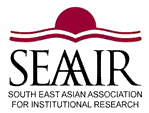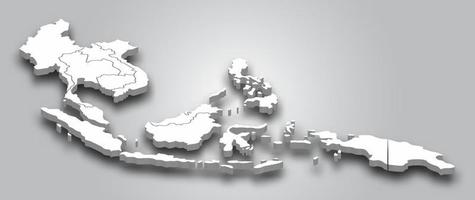| Welcome to SEAAIR |
 |
 |
| Home | About SEAAIR | Journal | Conference Info | Memberships | Others | Contact SEAAIR |
| |||||||||||||
| |||||||||||||
|
|
|
|
|
In early September 2000, an international group of senior academics from the region met at the International Medical University in Kuala Lumpur to discuss the possibility of forming a regional association for institutional research. Since then, the SEAAIR had prospered to become one of the most influential AIR affiliated groups for institutional research professionals.
Following interaction between AIR and Dr Raj Sharma (founder and Inaugural President of Australasian AIR), Raj organized a meeting on 5th September 2000,of an international group of senior academics from the region comprising Dr Zoraini Wati Abas (Director, Centre for Medical Education and Media, International Medical University (IMU), Malaysia), Prof Somwung Pitiyanuwat (then Vice President, Chulalongkorn University, Thailand), Prof Nirwan Idrus (the then Executive Director, The Indonesian Institute for Management Development, Indonesia), Prof Ken Heskin (then Deputy Vice-Chancellor and CEO, Swinburne Sarawak Institute of Technology) and Raj at the IMU in Kuala Lumpur to discuss the possibility of forming a regional association for institutional research.
The group decided that the time was appropriate for the formation of such an organization and undertook (i) to become the Interim Management Committee (IMC) for the organization and (ii) to organize a conference in late 2001 that would herald the birth of the organization and would attract participants from education, government, public service and industry. Dr Zoraini Wati Abas agreed to be the Chair of the IMC and Raj was elected Interim Hon. Secretary. It was decided that the inaugural conference would be held in Kuching and Professor Ken Heskin, Deputy Vice-Chancellor and CEO of Swinburne Sarawak Institute of Technology agreed to be the Conference Chair. It was agreed that delegates to the conference would automatically become members of SEAAIR and that the SEAAIR Executive Committee (SEC) would be elected at the inaugural General Meeting to be held at the conference. At that point, the Interim Management Committee would cease to exist.
The Interim SEAAIR Management Committee made a few other important decisions that shaped its future as follows:
Due to the relatively large geographical size of the region, the IMC decided to use electronic means of communication for its meetings as far as possible. Two groups of face-to-face meetings were to be held using the opportunities presented by the conference organization (one face to face meeting with the Local Conference Organizing Committee) and others (including the AGM) at the time of the conference.
The inaugural conference of SEAAIR was a great success with around 100 delegates attending the conference in Kuching, Sarawak, Malaysia. The Local Conference organization represented a unique partnership between the host institution (Swinburne Sarawak Institute of Technology), the Sarawak Government and the Sarawak Development Institute. It has also provided a useful institutional host model of SEAAIR conference organization in the future with the SEAAIR Executive Committee taking the primary responsibility for academic aspects of the conference and the local host(s) taking care of the operational and financial dimensions of the conference.
The first AGM of SEAAIR was held on 24 October 2001 at 12 noon in the Sarawak Chambers, Crowne Plaza Hotel, Kuching, the Conference Venue. The inaugural AGM made two important decisions:
The SEAAIR Executive Committee has been conscious of the fact that its membership has been drawn from a wide region and hence has deliberately rotated the conference host country/sub-region including peninsular part of Malaysia-Kuala Lumpur (2002), Bangkok, Thailand (2003) and Wenzhou, P.R.China (2004). Future conferences are expected to be held in Bali, Indonesia (2005), Tagaytay city or Subic Bay, Philippines (2006), Langkawi, Malaysia (2007) and either Chiangmai or Songkhla, Thailand (2008).
At its AGM during the 2004 SEAAIR Conference, the organization elected the following office bearers (namely, the SEAAIR Executive Committee or SEC) for a term concluding at the 2007 SEAAIR conference: Assoc Prof Zoraini Wati Abas (as President, now of Open University Malaysia), Asst Prof Teay Shawyun (as Vice President, of Assumption University, Thailand), Dr Raj Sharma (as Hon Secretary, of Swinburne University of Technology, Australia), Prof Nirwan Idrus (as Treasurer, now a Quality Assurance consultant),and Dr Jean Tayag (Philippines) and Dr Dyah Kusumastuti (Indonesia) as members-at-large. As provided by the SEAAIR Constitution, the President co-opted Ms Dai Jing of the International Affairs Office at Wenzhou University, China as the third member-at-large and thus forming the full compliments of the SEC.
The major purposes of the South East Asian Association for Institutional Research are to benefit, assist and advance research leading to improved understanding, planning and operations of institutions of post-secondary education in the region. Research focused on a single institution and also research that is concerned with groups of Institutions both fall within these purposes. In keeping with the dynamic nature of institutions of post-secondary education and the rapidly changing global environment in which they operate, the Association will encourage the application of appropriate methodologies and techniques from many disciplines. It will encourage comparative research into national higher education systems in South East Asia. It will publish and exchange information with respect to institutions of post-secondary education with a view to illuminating current and developing issues of common concern and raising the standard of post-secondary educational management, planning and policy development at all levels.
Its aims include:
SEAAIR has been addressing its aims through a number of programs and activities including:
Since its establishment in 2000 as a "baby" of the international IR family with other multi-national organizations such as AIR, EAIR, AAIR, and SAAIR having been formed earlier as well as such national bodies as Dutch AIR and the Canadian association (CIRPA-ACPRI), SEAAIR has progressed and evolved. SEAAIR celebrated its 20th Anniversary in 2020/2021 with a Kick-Off Anniversary Video at its 21st Annual Conference through Virtual Space due to the Covid-19 pandemic in 2019 with plans for a full-scale celebration in 2022 in Korea. Having matured at the golden age of 21, SEAAIR continues to look forward to working with these organizations to internationalize the cause of Institutional Research. It has since held conferences in most of the key ASEAN nations of the Philippines, Thailand, Malaysia, and Indonesia as 4 main pillars as supported by Vietnam and Singapore. SEAAIR has evolved into SEAAIR Plus by venturing into other countries like China, Korea, and Taiwan, with key participation from Japan and Australia, and other frequent nationalities' involvements.
JIRSEA has also matured with SEAAIR with its 19th Volume Issue to be issued in November-December 2021 (delayed from its normal September-October publication due to the delay in the 2020/21 Annual SEAAIR Conference). Most of the papers come from ASEAN, Asia, Australiasia, Middle-East, and once in a while Hong Kong SAR, Macau, U.S., and Africa. JIRSEA is a highly regarded SCOPUS indexed journal within the ASEAN accreditation agencies. It is also indexed in CARBELL Scholarly Analytics and EBSCO Academic Database that also index the Annual SEAAIR Conference Proceeding. 2020 to 2021 saw major changes and enhancements of JIRSEA as follows:
From 2022 onwards and into the near and far future, SEAAIR and JIRSEA continue to march on with their learning and sharing of academic and cultural platforms that include high-quality academic publications for a successful and sustainable SEAAIR and its community. This led "SEAAIR" to be more inclusive resulting in its evolution into "SEAAIR Plus" signifying the inclusion of Asian countries. The very basic aims as outlined in 2000 by its founding members are as valid in the past, the present, and the future that SEAAIR Plus will continue to pursue and uphold relentlessly and ethically through a non-politicized stand in the academic and cultural world.
Updated: November 3, 2021